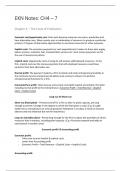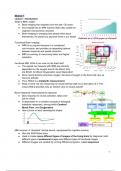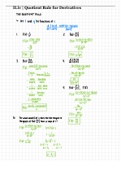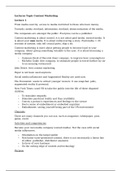EKN Notes: CH4 – 7
Chapter 4 – The Costs of Production
Economic cost/opportunity cost: Costs exist because resources are scarce, productive and
have alternative uses. When society uses a combination of resources to produce a particular
product, it forgoes all alternative opportunities to use those resources for other purposes.
Explicit costs: The monetary payments (or cash expenditures) it makes to those who supply
labour services, materials, fuel, transportation services etc. Such money payments are for
the use of resources by others.
Implicit costs: Opportunity costs of using its self-owned, selfemployed resources. To the
firm, implicit costs are the money payments that self-employed resources could have
earned in their best alternative use.
Normal profit: The payment made by a firm to obtain and retain entrepreneurial ability or
the minimum income entrepreneurial ability must receive to induce it to perform
entrepreneurial functions for a firm.
Economic/Pure profit: Total revenue minus total costs (both explicit and implicit, the latter
including normal profit to the entrepreneur). Economic Profit = Total Revenue - (Explicit
Costs + Implicit Costs)
Long-run VS Short-run
Short run (fixed plant) – Period too brief for a firm to alter its plant capacity, yet long
enough to permit a change in the degree to which the fixed plant is used. (E.g: If a gifts
maker has to manufacture set units of goods for Halloween in six days, it needs to increase
laborers and raw materials but not the machinery.)
Long run (variable plant) – Period long enough for the firm to adjust the quantities of all the
resources that it employs, including plant capacity. (E.g: A business expands and adds an
extra branch in another area)
Economic profit VS Accounting profit
Economic profit:
- Takes into account implicit & explicit costs
- Lower than Accounting profit
- Economic Profit = Total Revenue – (Explicit Costs + Implicit Costs)
Accounting profit:
, - Does NOT take into account implicit costs
- Hihgher than economic profit
- Accounting profit = Total Revenue – Explicit Costs
Relationship:
Short run production relationships:
total product (TP) - The total output of a particular good or service produced by a firm (or a
group of firms or the entire economy).
marginal product (MP) - The additional output produced when one additional unit of a
resource is employed (the quantity of all other resources employed remaining constant);
equal to the change in total product divided by the change in the quantity of a resource
employed. MP= ΔΤP/ Δinput
average product (AP) - The total output produced per unit of a resource employed (total
product divided by the quantity of that employed resource). AP= TP/input
Law of diminishing returns - As successive units of a variable resource are added to a fixed
resource,
beyond some point the extra, or marginal, product that can be attributed to each additional
unit of the variable resource decline. (Assumption – Technology is fixed).
,- AS units of labour increase, Total product will increase.
- This will happen at a increasing rate of Marginal returns.
- When the Marginal returns begin to diminins, the Total Product will still increase but
at a decreasing rate.
- As soon as the Marginal returns dips into the negative, the Total product will begin
to decrease.
- The Average product will increase, reach its peak, then decrease.
This process is illustrated through graphs:
, Short run production costs
fixed cost - Any cost that in total does not change when the firm changes its output; the cost
of fixed resources. E.g: insurance, property tax, advertising, salaries etc.
variable cost - A cost that in total increases when the firm increases its output and
decreases when the firm reduces its output. E.g: shipping/delivery, cost of raw materials,
commissions.
Total Cost(TC) - Sum of fixed cost and variable cost at each level of output
TC = TFC + TVC
Average fixed cost (AFC) - It is calculated by dividing total fixed cost (TFC) by each level of
output AFC = TFC/Q
Average variable cost (AVC) - Divide total variable cost (TVC) by each level of output
AVC = TVC/Q
Average total cost (ATC) - It is calculated by dividing total (TFC) by each level of output
ATC = TC/Q OR ATC = TC/Q = (TFC + TVC)/Q = TFC/Q + TVC/Q = AFC + AVC
Marginal cost (MC) - Extra cost of producing 1 more unit of output
MC = ΔΤC / ΔQ
Chapter 4 – The Costs of Production
Economic cost/opportunity cost: Costs exist because resources are scarce, productive and
have alternative uses. When society uses a combination of resources to produce a particular
product, it forgoes all alternative opportunities to use those resources for other purposes.
Explicit costs: The monetary payments (or cash expenditures) it makes to those who supply
labour services, materials, fuel, transportation services etc. Such money payments are for
the use of resources by others.
Implicit costs: Opportunity costs of using its self-owned, selfemployed resources. To the
firm, implicit costs are the money payments that self-employed resources could have
earned in their best alternative use.
Normal profit: The payment made by a firm to obtain and retain entrepreneurial ability or
the minimum income entrepreneurial ability must receive to induce it to perform
entrepreneurial functions for a firm.
Economic/Pure profit: Total revenue minus total costs (both explicit and implicit, the latter
including normal profit to the entrepreneur). Economic Profit = Total Revenue - (Explicit
Costs + Implicit Costs)
Long-run VS Short-run
Short run (fixed plant) – Period too brief for a firm to alter its plant capacity, yet long
enough to permit a change in the degree to which the fixed plant is used. (E.g: If a gifts
maker has to manufacture set units of goods for Halloween in six days, it needs to increase
laborers and raw materials but not the machinery.)
Long run (variable plant) – Period long enough for the firm to adjust the quantities of all the
resources that it employs, including plant capacity. (E.g: A business expands and adds an
extra branch in another area)
Economic profit VS Accounting profit
Economic profit:
- Takes into account implicit & explicit costs
- Lower than Accounting profit
- Economic Profit = Total Revenue – (Explicit Costs + Implicit Costs)
Accounting profit:
, - Does NOT take into account implicit costs
- Hihgher than economic profit
- Accounting profit = Total Revenue – Explicit Costs
Relationship:
Short run production relationships:
total product (TP) - The total output of a particular good or service produced by a firm (or a
group of firms or the entire economy).
marginal product (MP) - The additional output produced when one additional unit of a
resource is employed (the quantity of all other resources employed remaining constant);
equal to the change in total product divided by the change in the quantity of a resource
employed. MP= ΔΤP/ Δinput
average product (AP) - The total output produced per unit of a resource employed (total
product divided by the quantity of that employed resource). AP= TP/input
Law of diminishing returns - As successive units of a variable resource are added to a fixed
resource,
beyond some point the extra, or marginal, product that can be attributed to each additional
unit of the variable resource decline. (Assumption – Technology is fixed).
,- AS units of labour increase, Total product will increase.
- This will happen at a increasing rate of Marginal returns.
- When the Marginal returns begin to diminins, the Total Product will still increase but
at a decreasing rate.
- As soon as the Marginal returns dips into the negative, the Total product will begin
to decrease.
- The Average product will increase, reach its peak, then decrease.
This process is illustrated through graphs:
, Short run production costs
fixed cost - Any cost that in total does not change when the firm changes its output; the cost
of fixed resources. E.g: insurance, property tax, advertising, salaries etc.
variable cost - A cost that in total increases when the firm increases its output and
decreases when the firm reduces its output. E.g: shipping/delivery, cost of raw materials,
commissions.
Total Cost(TC) - Sum of fixed cost and variable cost at each level of output
TC = TFC + TVC
Average fixed cost (AFC) - It is calculated by dividing total fixed cost (TFC) by each level of
output AFC = TFC/Q
Average variable cost (AVC) - Divide total variable cost (TVC) by each level of output
AVC = TVC/Q
Average total cost (ATC) - It is calculated by dividing total (TFC) by each level of output
ATC = TC/Q OR ATC = TC/Q = (TFC + TVC)/Q = TFC/Q + TVC/Q = AFC + AVC
Marginal cost (MC) - Extra cost of producing 1 more unit of output
MC = ΔΤC / ΔQ











